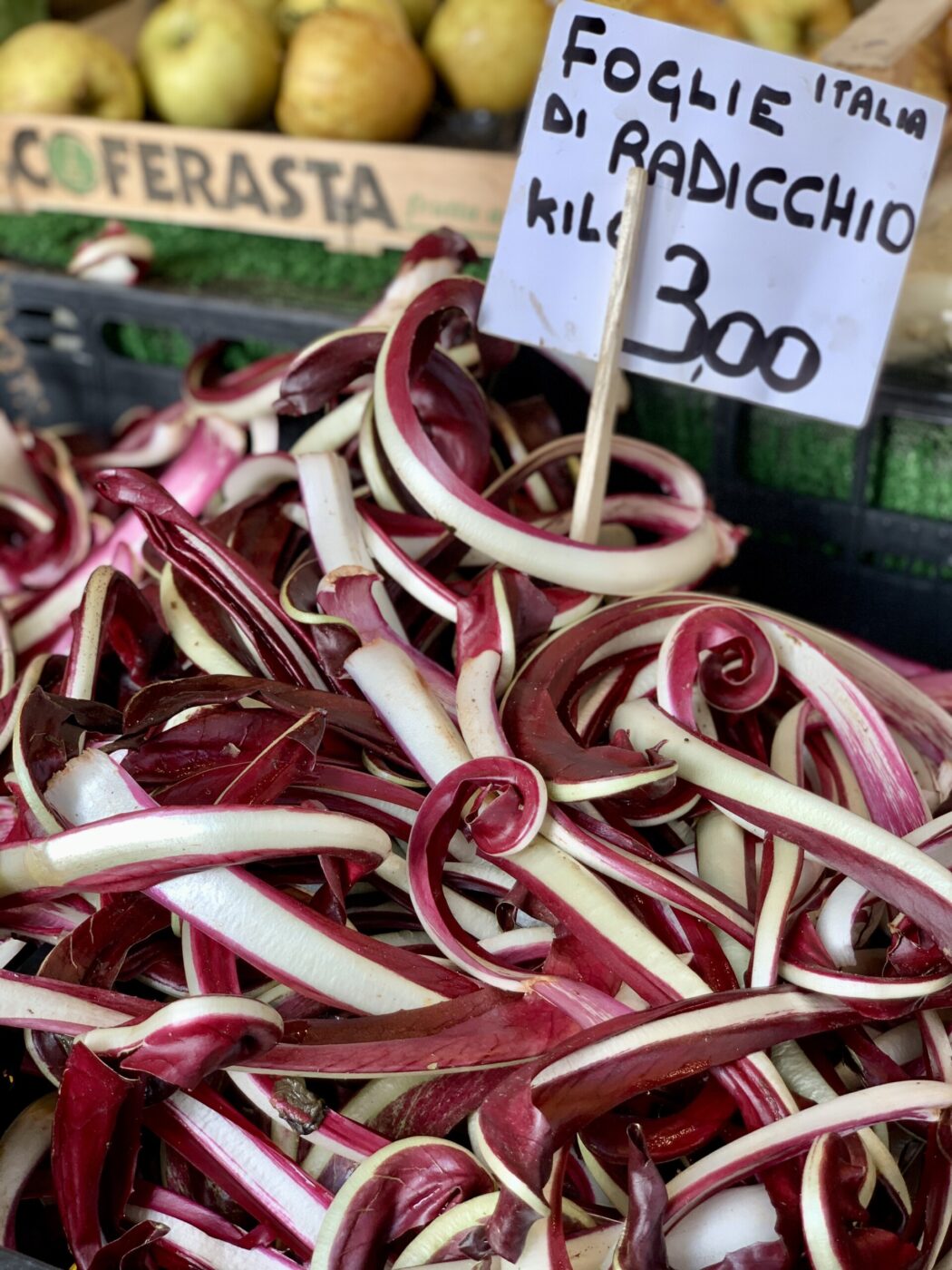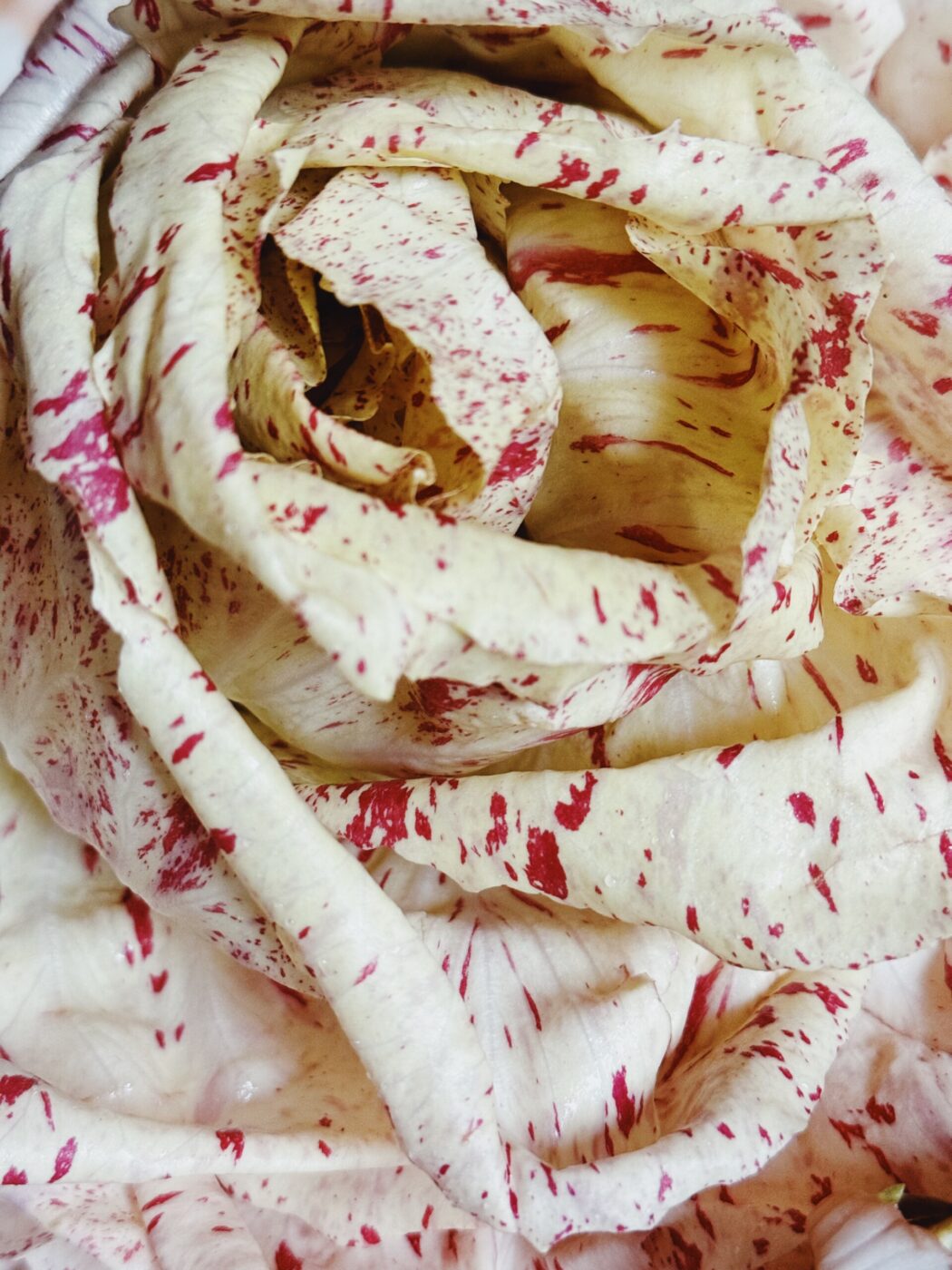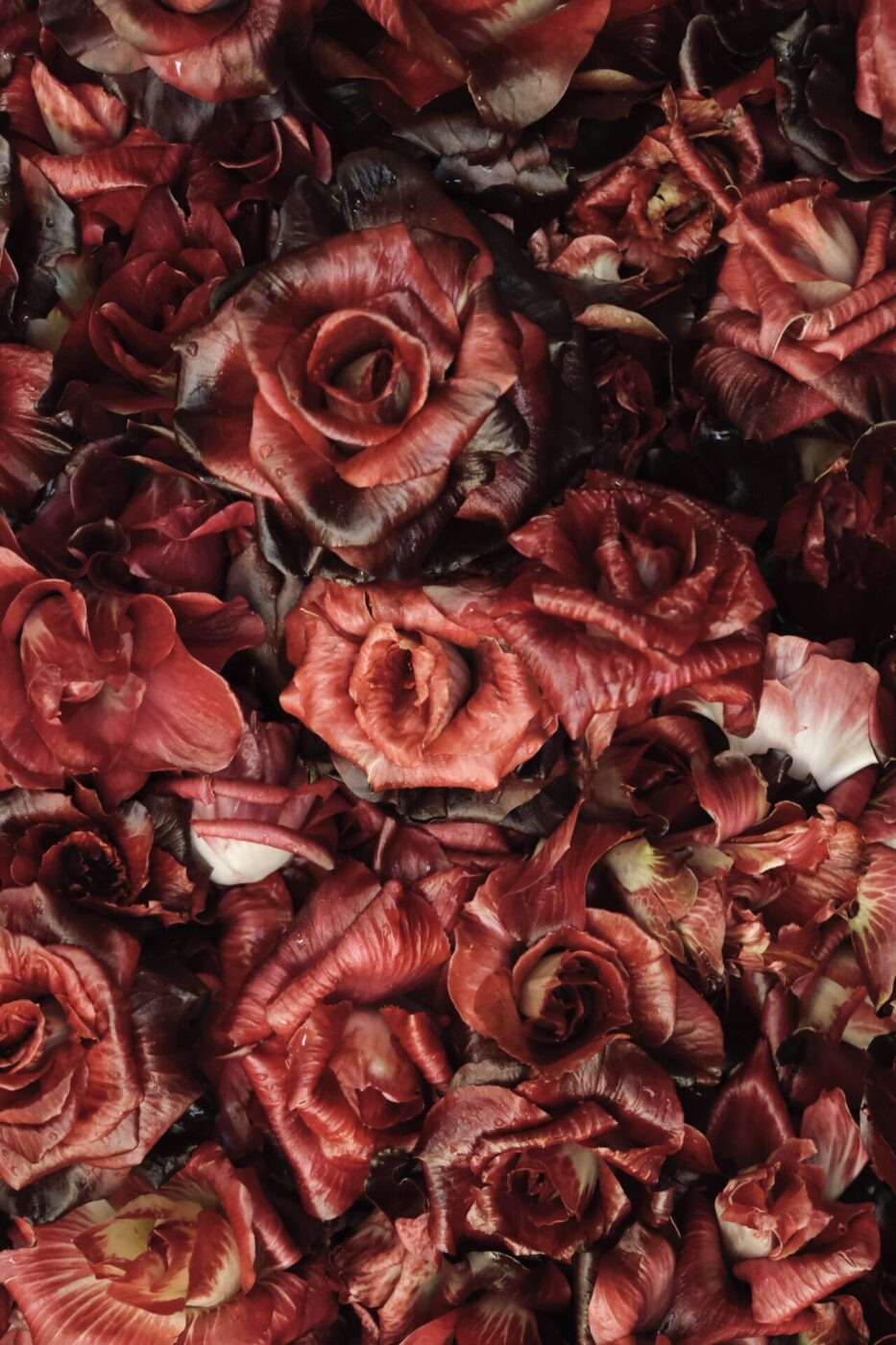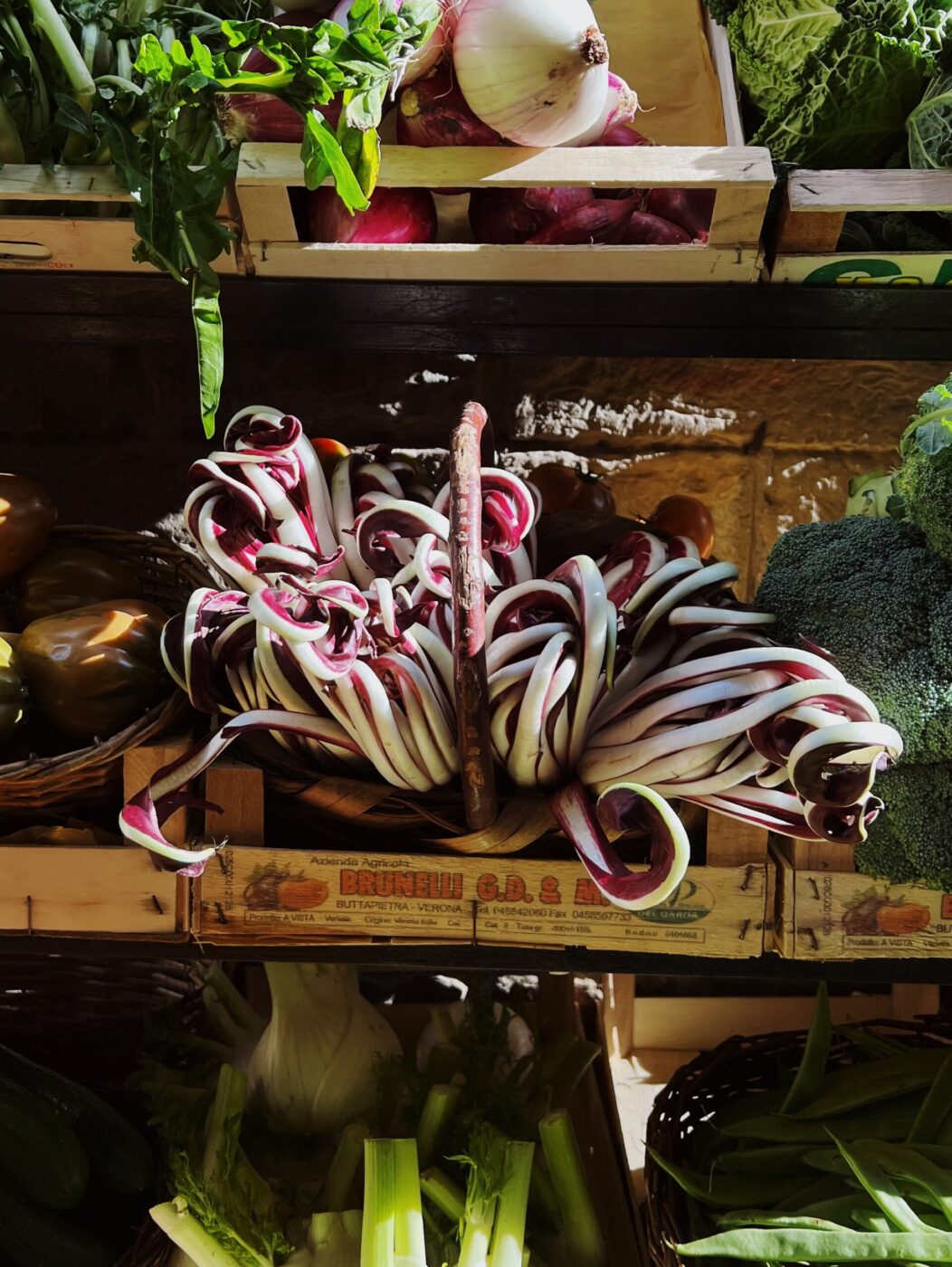Judge a radicchio by its cover, and you’ll find it to be pretty in pink, red, purple, yellow, white… But this beaut, beyond helping us eat the rainbow in the notoriously dreary cold seasons, contributes a bold bitterness to a number of preparations favored across the boot: raw in salads, sliced thin and stirred into risottos or soups, grilled, roasted, cooked up into a pasta sugo, added to panini and pizzas. For us Italians, its assertiveness–in both looks and flavor–is the perfect cure for dreary winter-weather cooking.
With soft, papery leaves bolstered by fibrous, crunchy ribs, radicchio is a member of the chicory family–its brethren include endive, escarole, and puntarelle–and begins to appear in mercati around late November. And, while most of the world knows only a certain red round one, we’re blessed with a veritable menagerie of varieties that last us through the winter. For this, we can mainly thank the region of Veneto, where the modern cultivation of the vegetable started in the 15th century–though the first can be traced back to ancient Egypt. Even Pliny the Elder loved the stuff back then, citing its benefits as a blood purifier and remedy for insomnia. The region has held on tight to its star vegetable, and today is the country’s top radicchio producer and home to superb varieties protected under the IGP label. One of them, the Radicchio Rosso Tardivo, is thought to be the oldest variety cultivated here and the ancestor of many other Italian varieties.
While some types of radicchio are more intense (Chioggia) and others milder (Castelfranco), all feature a shamelessly sharp flavor profile that particularly suits the likes of baby greens; creamy legumes like white beans or chickpeas; oily nuts like hazelnuts and walnuts; cheeses, either soft like burrata and ricotta or strong like gorgonzola and taleggio; and starchy vegetables like potatoes and squash.
Here, a guide to the 8 varieties of Italian radicchio that you should know about (among countless others!), as well as some of our favorite ways to eat them.
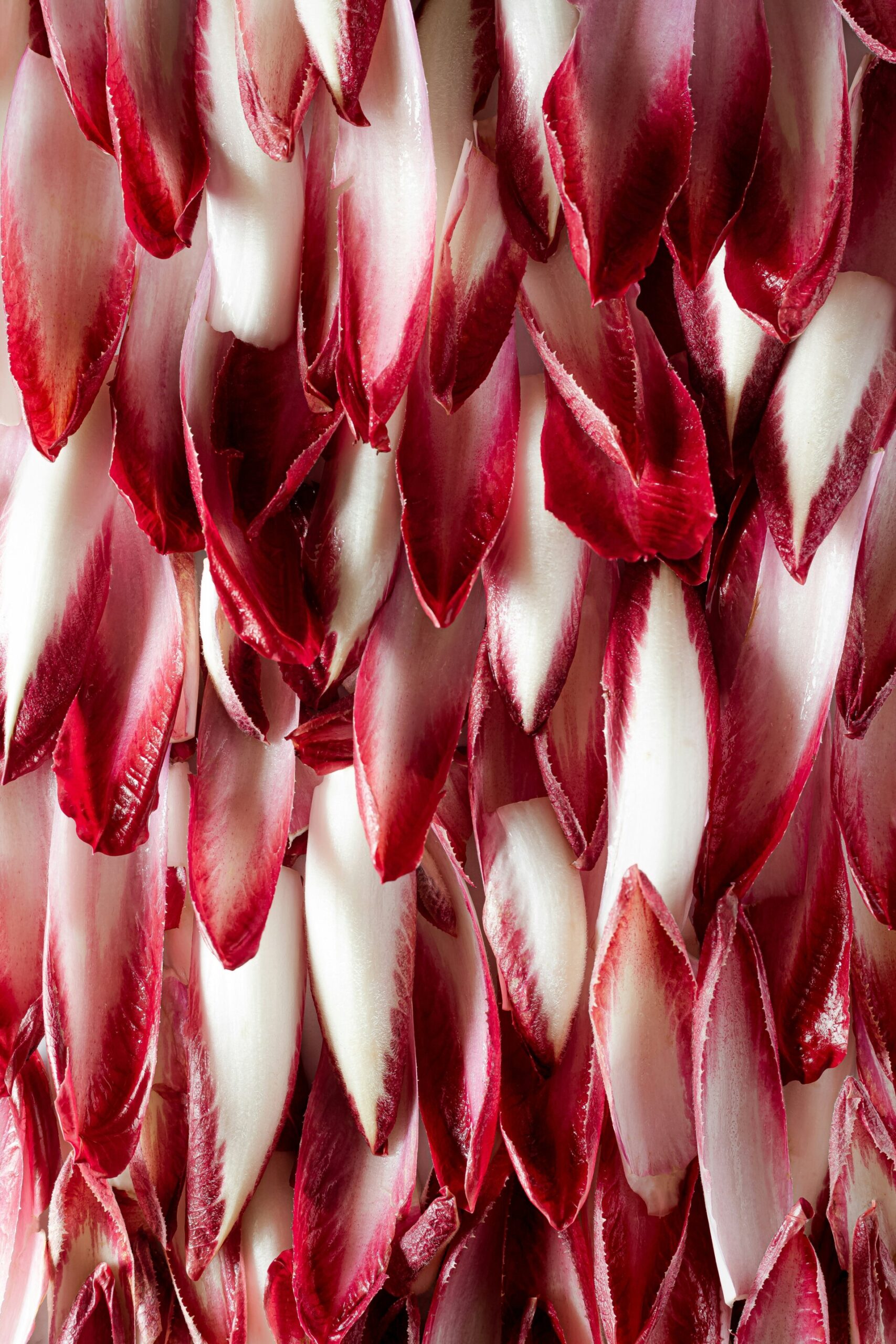
Radicchio di Verona
RADICCHIO DI TREVISO (IGP)
One of Italy’s most prized radicchios, the so-called “king of radicchio” comes in two guises: the Precoce, which comes into season first and is softer in form and flavor, and the Tardivo (or Spadone), which is harvested in the middle of winter, after (at least) two frosts, for a strong bite and bitterness. Both are grown under rigorous IGP conditions overseen by the Consorzio Radicchio di Treviso.
Appearance: Precoce are long and football-shaped, reminiscent of romaine lettuce, with a purple-red color and white ribs. Tardivo have long, thin leaves that curl up on themselves, making the whole thing look like a tangle of octopus tentacles; primarily white, with a purple-red along the edges and tips.
Culinary Uses: Precoce is great in salads, though its shape also lends itself to grilling and baking. Tardivo’s firmness makes it great for cooking; pair it with an unctuous nut like hazelnut or walnut or a strong cheese like taleggio to temper its flavor.
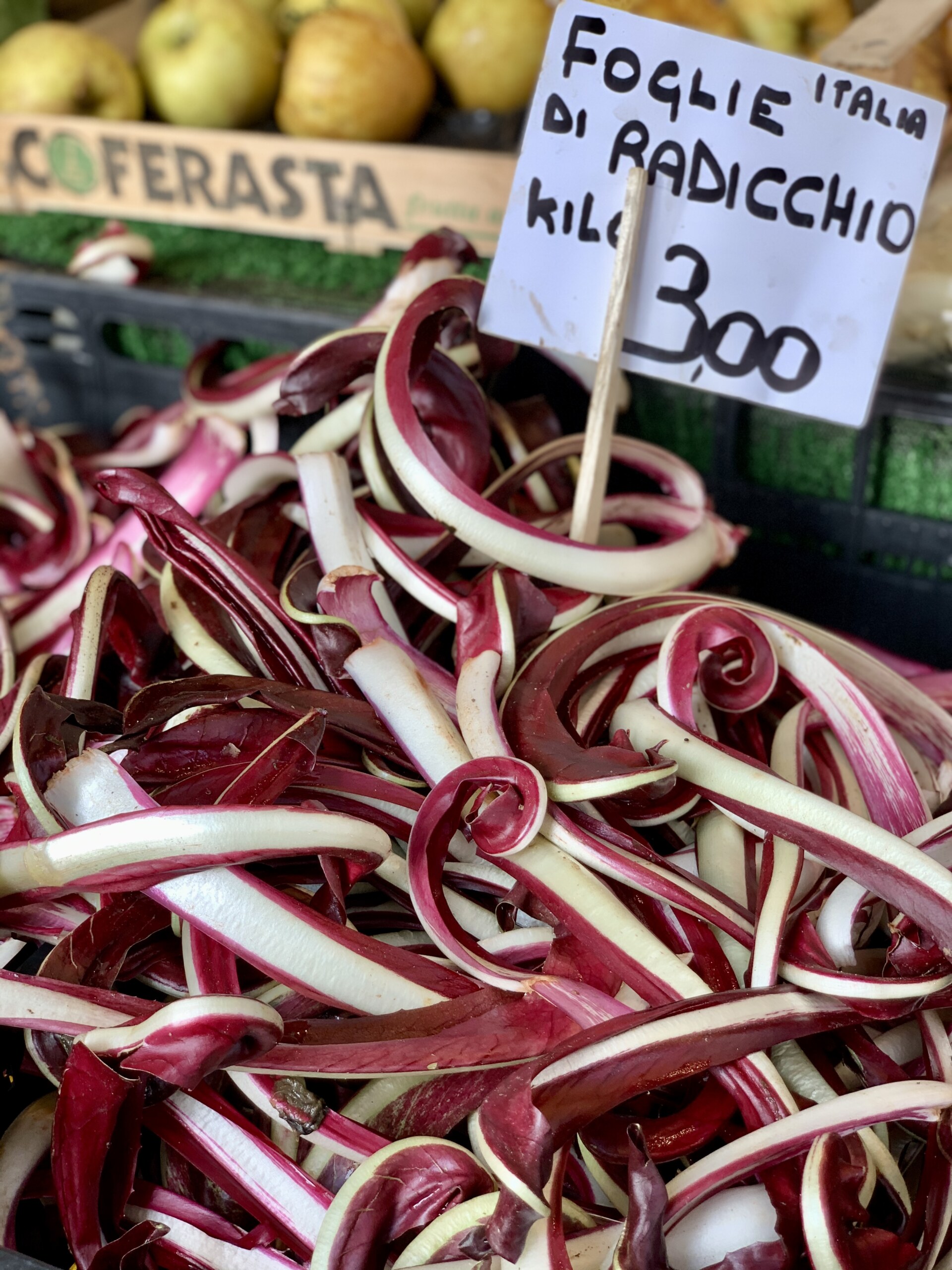
Photo by Camilla Purdon @millpurdon
RADICCHIO VARIEGATO DI CASTELFRANCO (IGP)
The most delicate of the bunch, radicchio di Castelfranco is a cross-breed between radicchio di Treviso and escarole developed at the end of the 19th century. Also known as the Fiore d’Inverno (winter flower), the variety is protected by an IGP covering municipalities in the provinces of Treviso, Padova, and Venice.
Appearance: Yellow-hued leaves with pink and red speckles; more lettuce-like, or rose-like, if you’re feeling romantic.
Culinary Uses: This is one to assolutamente keep raw! Season simply with olive oil and salt, or compose a salad with a tangy cheese like robiola or a funky one like gorgonzola, hazelnuts, and a drizzle of honey.

Radicchio di Castelfranco
RADICCHIO DI CHIOGGIA (IGP)
This variety, bred for its deep purple-red color between the 1930s and ‘50s, is the most widely available both in Italy and worldwide. While it’s grown extensively in California for mass distribution, in Italy, only producers from the area between Chioggia and Rosolina can use the IGP label.
Appearance: Small and spherical, about the size of a grapefruit, with densely packed leaves; cabbage-like. White ribs and dark purple-red leaves with a color reminiscent of Barolo.
Culinary Uses: The world is your oyster with this versatile variety: grilled, roasted, cooked into pastas (with sausage is great), or even added atop pizzas.
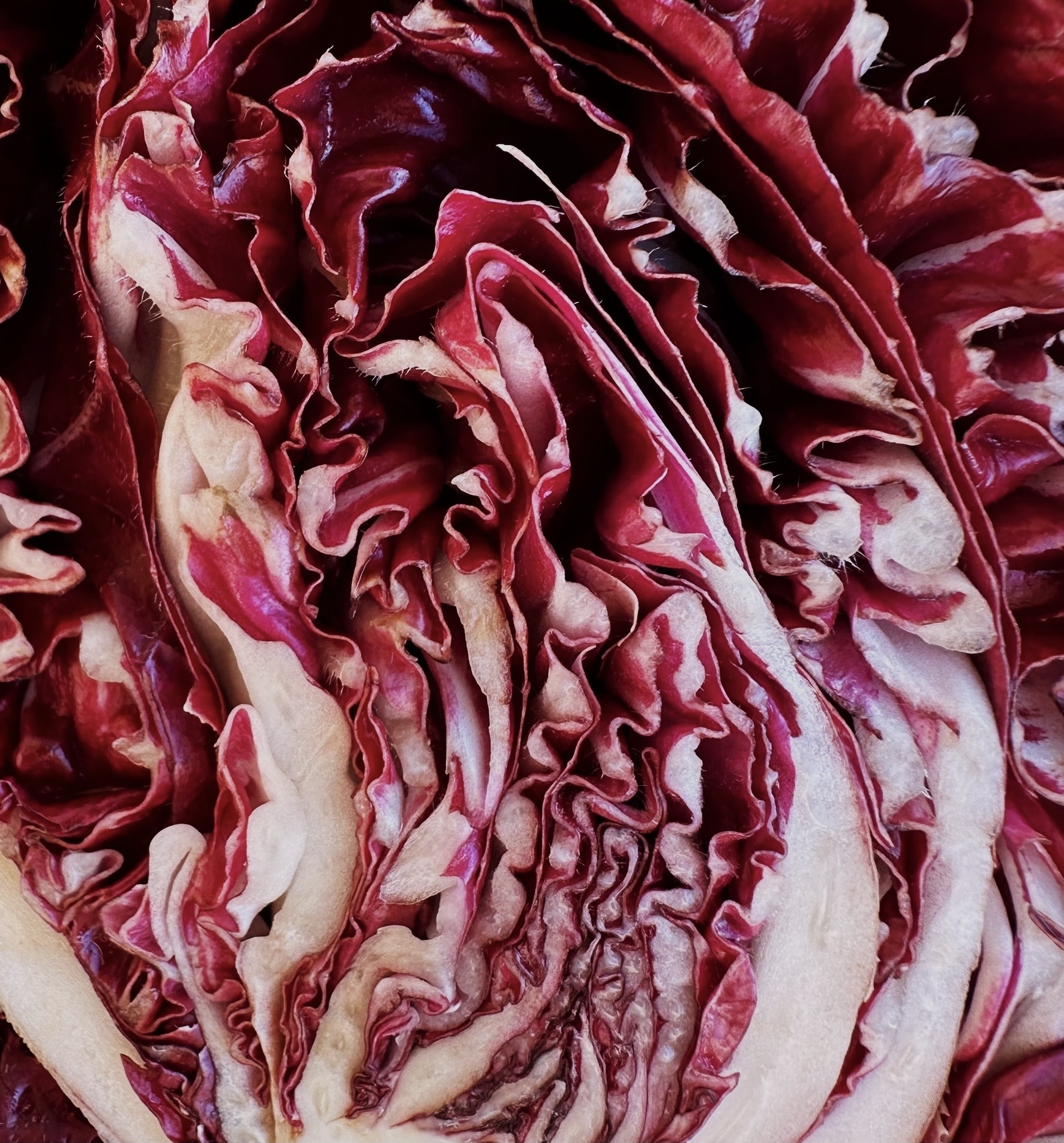
Radicchio di Chioggia
ROSA DI GORIZIA
Moving beyond Veneto to Friuli, another top-notch radicchio producer, we find this rare variety which boasts a Slow Food Presidium and which locals know as the “regina dell’inverno” (“winter queen”). The radicchio has been grown in Gorizia, which straddles Italy and Slovenia, since Habsburg times, with the first recorded mention coming from baron Carl von Czoernig in 1784. After the outer leaves wither and die, only about 20% of the plant remains usable, and the crop is so labor- and time-intensive that only a few farmers still cultivate it; a 2018 survey counted just 12 Italian growers and even fewer in Slovenia. All this makes it the most expensive radicchio in the world, as it’s often clocking in at close to €25 per kilo.
Appearance: A dark red, freshly bloomed rose (hence the name); they’re quite small, with heads about the size of a mandarin. (When they’re first harvested, the color is so dark as to be gothly; the roses are then left for two weeks in complete darkness, which actually causes them to lighten up.)
Culinary Uses: In Friuli, the rosa di Gorizia is most often dressed with ciccioli–pieces of prosciutto or pork lard, cooked down with balsamic vinegar–so that the meaty reduction coats the leaves. Locally, it’s also served in a salad with apple (or pear), speck (or pancetta), and Montasio cheese and alongside frico, among other preparations.
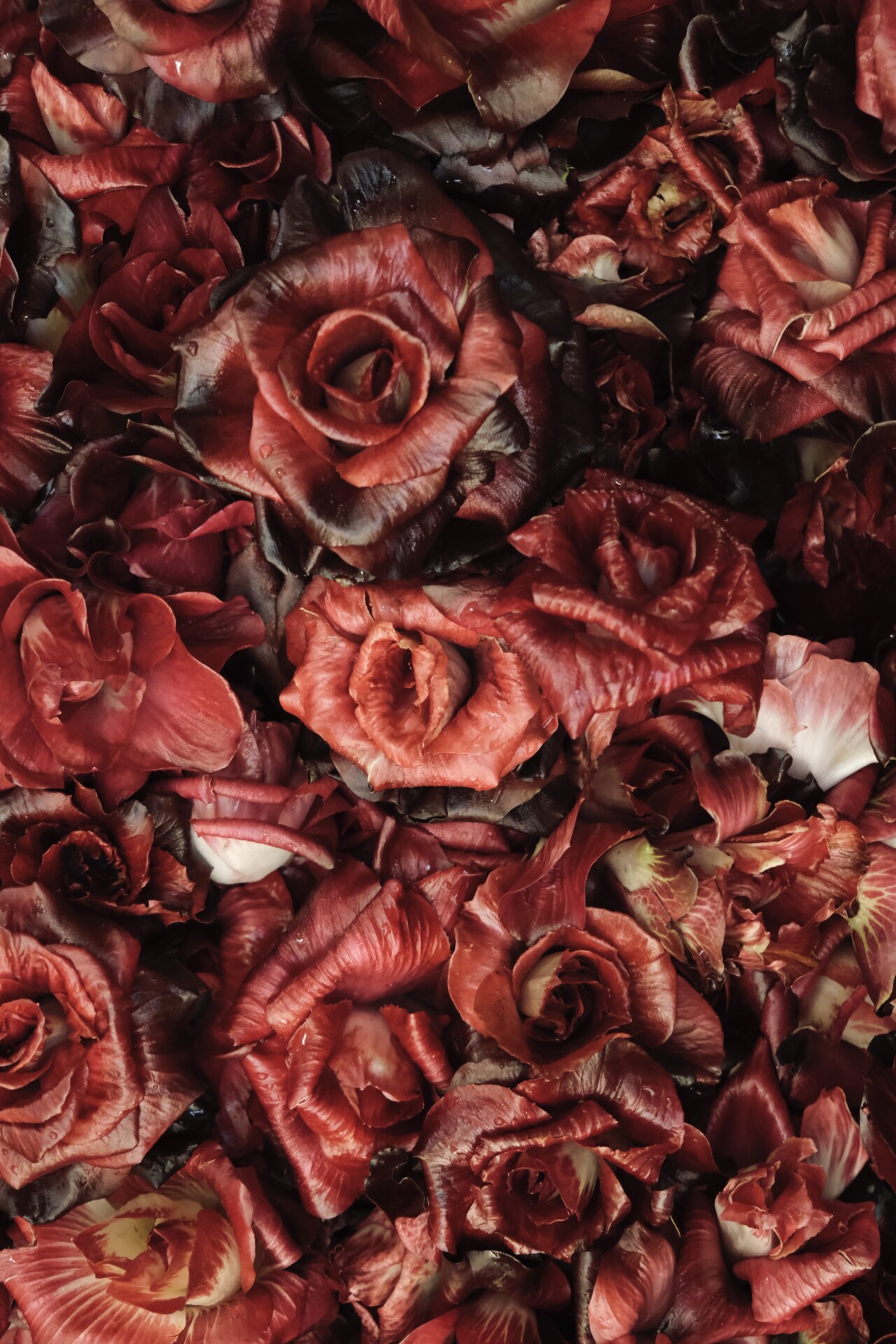
Rosa di Gorizia
RADICCHIO CANARINO
In the 1950s, a new variety emerged from selectively breeding the rosa di Gorizia: the radicchio Canarino, or canary radicchio–identical to its progenitor in every way except for color.
Appearance: True to its name, the radicchio boasts a bright canary-yellow hue and, occasionally, reddish tints that travel up from the heart in a disconcertingly vein-like way.
Culinary Uses: See above.
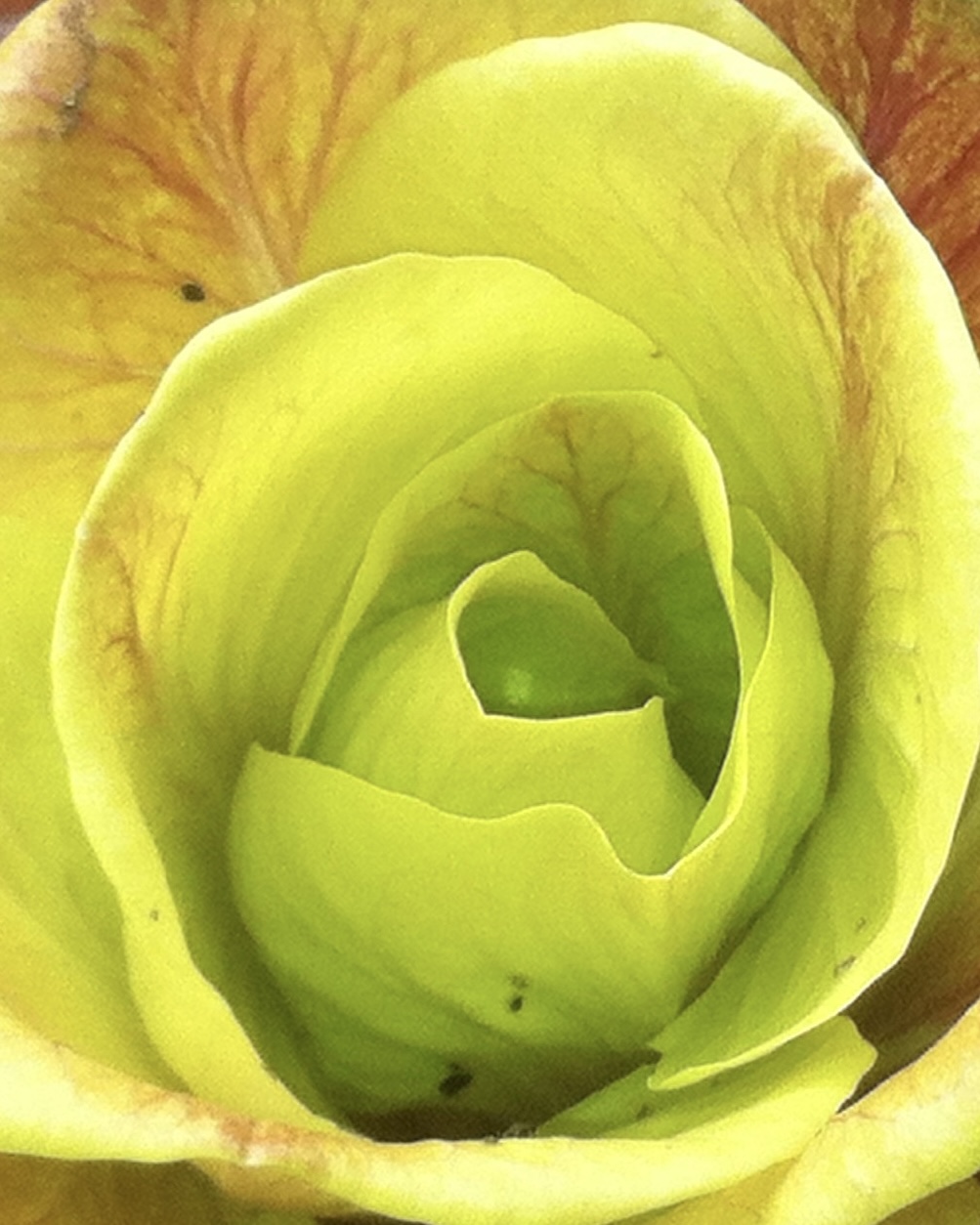
Radicchio Canarino
RADICCHIO DI VERONA (IGP)
Another offshoot of the radicchio di Treviso, the radicchio di Verona, which has a sweeter flavor than its siblings, is, surprise surprise, grown in the area around the city of Verona under an IGP.
Appearance: Tidy and almost egg-shaped, with bright purple leaves and white ribs, averaging 10 to 15 centimeters in length.
Culinary Uses: This is your perfect risotto radicchio. Add saffron if you’re feeling fancy.

Radicchio di Verona
RADICCHIO ROSA DEL VENETO
This blushing bride from Veneto makes a fleeting appearance in the markets, gracing us from mid to late winter through early spring. A crossbreed of the white radicchio from Lusia and the vibrant red variety from Verona, it has a more delicate flavor than its decisive siblings.
Appearance: Long and oblong, with the prettiest baby pink you’ve ever seen.
Culinary Uses: This is another one to keep raw, paired with salumi, seasonal fruits, or even fish.
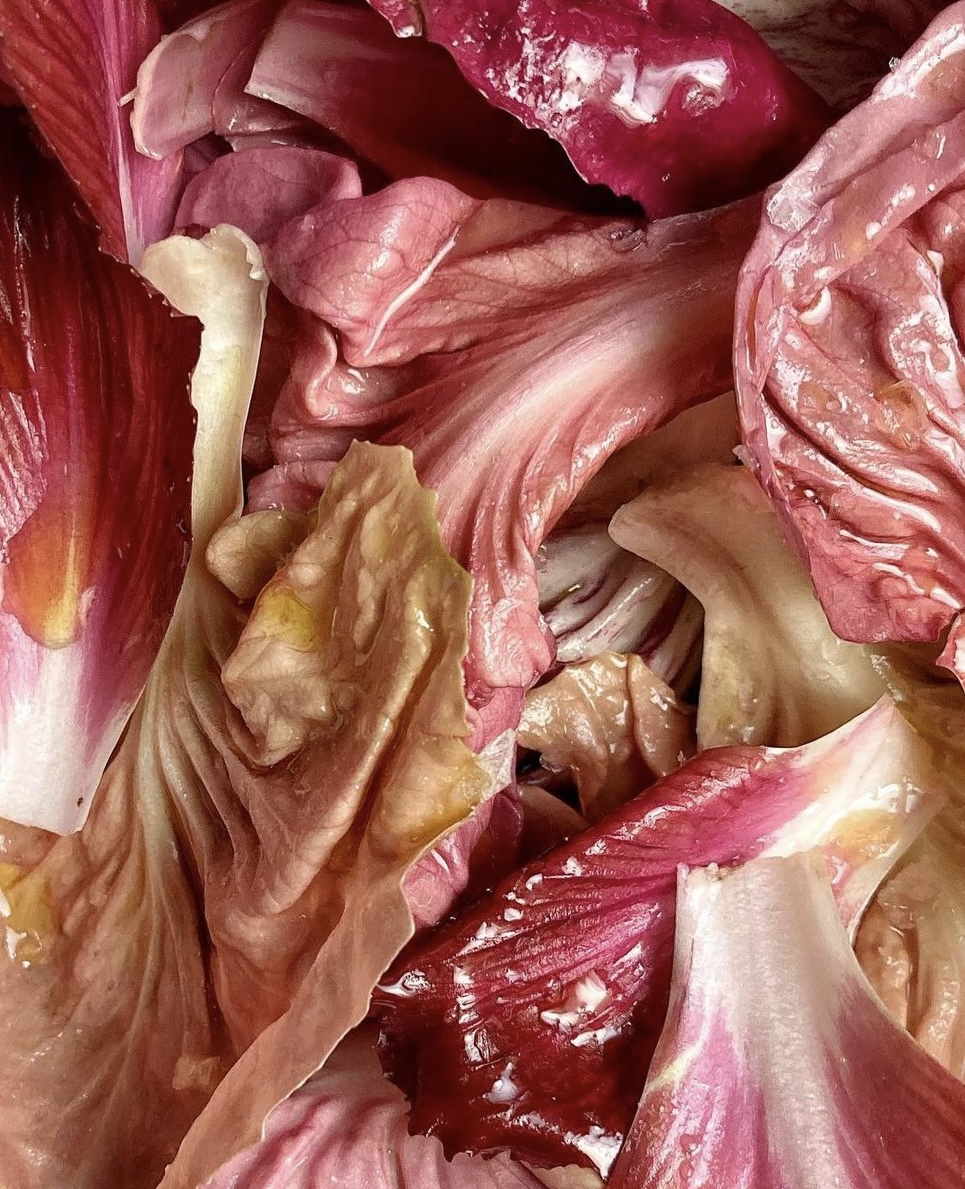
Radicchio Rosa del Veneto


